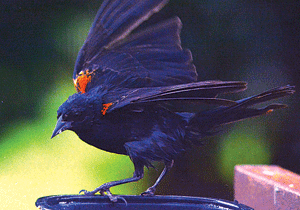WELCOMING OCTOBER’S SIGNS OF FALL
 October has come, October with its bright blue weather.
October has come, October with its bright blue weather.
It’s October, and more and more tree leaves are changing to the colors of fall. Cottonwood tree leaves are turning yellow, maple leaves are changing to red and yellow. Oak leaves are becoming red and yellow and brown. Sumac leaves are dark red.
These are days when the sky is gray, not blue, days when frost covers the ground and a strong cold wind blows from the north, whipping leaves from the trees and scattering them across the ground. On those days, a skim of ice covers puddles and lakes and ponds and slow flowing streams. On those gray sky days, winter seems just a day or two away.
Goldenrod is in bloom, patches of yellow amid the brown turning weeks and grass where the mowers have not been. Beyond our pasture in a few acres where we scattered seeds of native prairie plants, the yellow blossoms of Maxmillian’s sunflower cover the field.
Bird migration, which began two months ago with a few species of shorebirds that nest farther north, is at or near its fall peak.
Robins are gone from our yards, gathered in flocks, some already wining their way south, those that haven’t started south confining their activities to woods.
Red-winged blackbirds are in flocks, segregated flocks, males together, females together with only a few intruders of the opposite sex in any flock. Like robins, they have deserted the marshes and fields where they nested and now drift about the countryside, settling here and there in grassy fields where they search for insects and seeds or in fields of corn where they pry open the ears and feed on the kernels.
At night, they roost in dense cattails in marshes or in thick trees and brush in wetlands, still segregated; males together and females together.
Warblers have been moving for a month or more. The common yellowthroats that nested in the cattails in our marsh, the redstarts that nested in the trees of the nearby park were among the first to go, to start south.
Last month and this, warblers that nested farther north have been drifting through our area. In their dull non-breeding plumage, eclipse plumage, and silent most of the time, they are hard to spot among the leaves that still hang on the trees and bushes.
Sparrows, little brown jobs or LBJs, are also silent most of the time and even harder to spot than warblers.
Daily, when I watch my bird feeders, I look for a winter visitor among the resident birds, the birds that stay with us year-round; house sparrows, mourning doves, cardinals, black-capped chickadees, tufted titmice, downy woodpeckers and white-breasted nuthatches.
Will I see a red-breasted nuthatch at one of my feeders this winter? Will I see a redpoll or a purple finch? Will there be an invasion of pine siskins as there was last winter?
Squirrels are caching and burying nuts. Young deer have lost their spots and are nearly as big or as big as their mothers.
Woodchucks are keg-shaped. They look almost as broad as they are tall when they stand erect. Soon they will disappear, going underground for a long winter’s nap.
Raccoons are wandering, looking for food and for places to hole up for the winter. I’ve seen more dead raccoons along the roads than any other animals lately.
It’s October. Fall.
Rapidly changing weather, bright blue sky one day, stormy gray the next, goldenrod and Maximillian’s sunflowers in bloom, leaves on the trees changing colors, falling, the plumage and activities of birds, deer and woodchucks, squirrels and raccoons all indicate that fall is here as clearly as the calendar on my study wall.
- Birds As Weather Forecasters – Life In The Outdoors - December 17, 2021
- Rare Bird Spotted In Indiana – Life In The Outdoors - October 8, 2021
- MY EXPERIENCE WITH DEER – Life In The Outdoors - July 30, 2021


